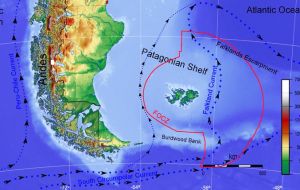MercoPress. South Atlantic News Agency
Marine Protected Areas controversy in the South Atlantic
 Falklands government said it “believes the designation of this area encroaches on our Fisheries Conservation Zone and steps are being taken to address the matter” (Pic FIG)
Falklands government said it “believes the designation of this area encroaches on our Fisheries Conservation Zone and steps are being taken to address the matter” (Pic FIG)  The two MPAs are Yaganes located just off the southern tip of Argentina, “the end of the world” and the Namuncurá-Burdwood Bank II, in the South Atlantic (Pic Wikipedia)
The two MPAs are Yaganes located just off the southern tip of Argentina, “the end of the world” and the Namuncurá-Burdwood Bank II, in the South Atlantic (Pic Wikipedia)  Alex Muñoz leads the Latin American arm of National Geographic's Pristine Seas program; Sofia Heinonen is head of Argentina's Flora and Fauna Foundation (Pic Twitter)
Alex Muñoz leads the Latin American arm of National Geographic's Pristine Seas program; Sofia Heinonen is head of Argentina's Flora and Fauna Foundation (Pic Twitter) In a brief communiqué released on Friday the Falkland Islands government takes note of a recent Argentine announcement indicating the creation of Marine Protected Areas to the south of the Budrwood Bank. The Falklands government said it “believes the designation of this area encroaches on our Fisheries Conservation Zone and steps are being taken to address the matter”.
However a recent article from National Geographic sheds some light on the creation process of two marine protected areas, “the size of Hungary”, which apparently had the sponsoring and/or support from the National Geographic's Pristine Seas program Latin American branch, and strong lobbying from the Argentine Flora and Fauna Foundation.
One of the MPA's is called Yaganes and is located just off the southern tip of Argentina—a spot nicknamed “the end of the world.”
The other, Namuncurá-Burdwood Bank II, is in the South Atlantic. According to the National Geographic article portions of these new MPAs have remained pristine by default of their remoteness, and the Argentine government’s decision to protect them ensures that the marine ecosystems will stay that way.
Conservationists are hoping this move signals a shift toward stronger conservation measures in the country. Not only because the decision designates more protected territory, but also because it comes with a legal framework to enforce the new restrictions.
“It's much more than creating two national parks,” says Sofia Heinonen, president of the Argentine Flora and Fauna Foundation, an environmental group that led a campaign in favor of the new marine parks. “This also creates the basis for the next one.”
Previously, Argentina's marine parks were managed by the same government department that manages its fisheries, which are open to commercial interests. This left little funding to stop illegal activity in the parks that could undermine bans on extractive activities like fishing there.
An earlier Argentine MPA called Namuncurá-Burdwood Bank I, created in 2013 (Bill 26.875), had weak oversight. A legal framework to manage the park wasn’t passed until 2015, and Argentina’s National Parks Administration didn’t gain control until 2017.t e e
At the same time, “fishing pressure has increased immediately south of Argentina in recent years. So in an attempt to protect Argentina’s waters, the National Geographic Society partnered with the Forum for the Conservation of the Patagonian Sea and local governments to survey the region. The goal was to assess the health of the marine ecosystems known for their impressive biodiversity”.
“We wrote very comprehensive scientific reports that supported the immense ecological value of this area and the need for protection,” explains Alex Muñoz, the leader of the Latin American arm of National Geographic's Pristine Seas program.
”Earlier this year, Argentine Flora and Fauna Foundation and the National Geographic Society received part of a record one billion US dollars donation made by the conservation-focused Wyss Foundation to groups working to create natural reserves like marine protected areas and national parks,
During National Geographic's recent exploration of Yaganes and Namuncurá-Burdwood Bank, researchers and photographers maneuvered cameras more than 6,000 feet below the surface. They found underwater mountain ranges and deep-sea canyons home to an impressive array of diversity. Many of the species identified can only be found in this part of the world.
With the creation of these two new marine protected areas, 8% of Argentina’s waters are now protected, bringing the country closer to its goal of protecting 10 percent of its national waters by 2020.
MPAs are a popular tool used by governments to meet the United Nations’ larger goal of protecting 10%of the world’s oceans by 2020.
“Argentina is catching up on marine conservation,” Muñoz says. “Now it's becoming a world leader in world conservation.”
Finally the National Geographic piece quotes Heinonen saying “her organization’s future conservation work will involve talks with Chile, a country that also shares close proximity to Antarctica. They hope to create joint protected areas in the South Atlantic Ocean”.




Top Comments
Disclaimer & comment rulesCommenting for this story is now closed.
If you have a Facebook account, become a fan and comment on our Facebook Page!